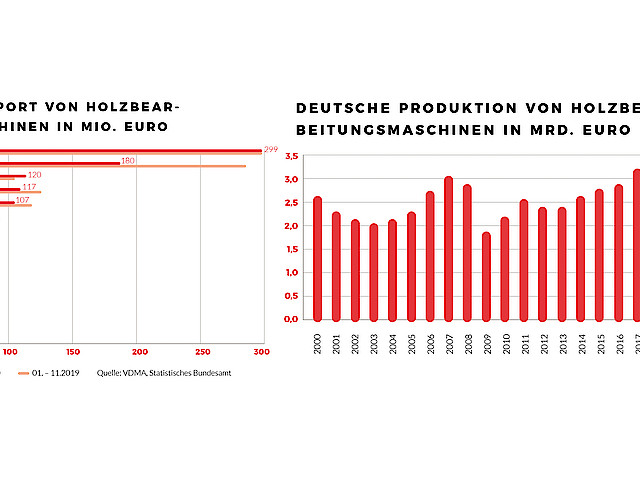

The pandemic dominates the headlines. For us, the most interesting aspect about the Corona virus is how it affects the furniture industry and in particular industrial equipment suppliers to the furniture industry. To learn how the pandemic impacts these industries, we talked with Dominik Wolfschütz from the German association of machinery and industrial equipment manufacturers "VDMA”.

THE PANDEMIC DOMINATES THE HEADLINES. FOR US, THE MOST INTERESTING ASPECT ABOUT THE CORONA VIRUS IS HOW IT AFFECTS THE FURNITURE INDUSTRY AND IN PARTICULAR INDUSTRIAL EQUIPMENT SUPPLIERS TO THE FURNITURE INDUSTRY. TO LEARN HOW THE PANDEMIC IMPACTS THESE INDUSTRIES, WE TALKED WITH DOMINIK WOLFSCHÜTZ FROM THE GERMAN ASSOCIATION OF MACHINERY AND INDUSTRIAL EQUIPMENT MANUFACTURERS "VDMA”.

Travel restrictions have a negative impact on industrial equipment manufacturers when it comes to installation and commissioning of plant and equipment beyond the borders of Germany or Austria. Due to the delays in final acceptance tests, both the plant operating companies and suppliers are under great financial pressure. Though some manufacturers offer online commissioning of machines and workcells, this is not an equal substitute for on-site meetings. In fact, virtual meetings are no substitute for face-to-face encounters.
For the equipment suppliers to the wood and furniture manufacturing industry, preliminary figures showed all top markets fell, except for China (No. 1) and Austria (No. 3). However, we are coming down from a record peak in 2019, and moreover, industrial equipment manufacturing is a cyclical industry that has learned how to cope with the ups and downs.
According to the figures of the Main Association of the German Wood Industry (”HDH”), at the end of the year, companies were able to almost level out the losses suffered in spring. For the kitchen furniture segment, forecasters predict positive year-end results. Here strong business figures are fuelling the investment willingness of the manufacturers. In addition to the big players, also small niche suppliers intend to invest in new equipment. In the medium run, i.e. in the years to come, production quantities in the kitchen furniture segment are expected to grow by more than 30 %. However, this growth will massively accelerate consolidation of the entire industry – independently of the Covid-19 situation. This is true for Germany as well as for France and the Benelux countries, the main buyers of German kitchens.
Office furniture suppliers and living furniture manufacturers reported negative sales. These sectors are hardest hit by the closure of non-essential retail during the lockdown. Nonetheless, the large number of incoming orders in the last months of 2020 is giving grounds for cautious optimism in the industry, with many sectors being dependent on the re-opening of retail.
People were spending more money on furniture long before the pandemic struck. Specifically the manufacturers of kitchen furniture and living furniture were benefiting from this trend. This was partly due to the cocooning effect. But there is a risk that consumer behaviour could change after the pandemic. Maybe then the yearning for personal encounters and (long-distance) journeys is so great that investments in home beautification loose some of their importance.
With a 60 percent global market share, Europe is the most important market for German and Austrian machine manufacturers with regard to the number of orders placed. In the DACH region (Germany, Austria, Switzerland), we are well on target; in some segments, even exceeding the target. However, business activity continues to pick up only slowly, especially in the countries hardest hit by the virus (Italy, France, Spain, Portugal).
On an international scale, China has very quickly recovered from the COVID-19 crash. Chinese manufacturers invest strongly in batch-size-1 production technology in order to be able to supply customized furniture to the domestic market. Hence some companies are expanding rapidly.
Also the US furniture industry sees a relatively constant propensity to invest – specifically among cabinet manufacturers. One reason could be the high U.S. antidumping and countervailing duties on Chinese imports. These sanctioning measures improve the competitiveness of American manufacturers.
The indirect effects of the pandemic – for example the weakening of other countries' currencies vis-à-vis the Euro currency – not only affect industrial equipment suppliers but also export-oriented furniture manufacturers. This leads to higher domestic currency prices of our products in the countries concerned (amongst them Turkey, Brazil), which risks weakening our competitiveness in these countries.
All in all, carpenters’ and joiners’ order books are well filled. Like all small workshops, they have to handle a heavy workload – despite the pandemic. And full order books increase the willingness to invest in machine technology. However, many businesses suffer from lack of qualified personnel, and specifically shopfitting, exhibition construction and hotel furniture supply have been the sectors worst hit by the pandemic. Some of the companies in this segment fear they may not survive the coronavirus crisis.
Even the joineries that report full order books are worried about the effects of the pandemic over the medium term: cuts in government spending on buildings as well as a substantially higher fiscal deficit could lead to a reluctance of public institutions to invest. Also the structural change in the automotive industry could have negative effects. Job losses in this industry will mean that small workshops will lose affluent customers.
This is of particular interest to industrial equipment suppliers: all in all, the number of joineries with complete in-house production is decreasing more and more. In fact, an increasingly greater number of joiners order pre-fabricated components from specialist manufacturers (e.g. Egger), a trend likely to reduce the willingness of small joineries to invest in certain types of machines. On the other hand, the equipment utilized by component suppliers is getting more and more complex to allow them to satisfy all customer needs “just in time”: a fascinating challenge for industrial equipment suppliers.
Industrial equipment suppliers will gain new customers. Also IMA Schelling has equipped some online suppliers. Moreover, an increasingly greater number of furniture manufacturers engage in online trading. Whenever these companies offer customized products, this will be a good chance for industrial equipment manufacturers like IMA Schelling since the complexity of the equipment increases.
But online trading has its limits: it cannot create a holistic experience using all the 5 senses. Hence, physical presence remains important because physical retail is still where the value is – which is especially true for expensive high-end products.
We notice than an increasing number of our customers buy into small software businesses. The AR know-how acquired in this way allows them to create completely new offers for their customers. Moreover, real experience in virtual space gives many furniture makers and also flooring manufacturers the possibility to present themselves to a global clientele. AR enables suppliers to win new customers they could not have reached that easily in other ways.
Augmented Reality is also rapidly gaining importance for the industrial equipment industry and hence also for equipment suppliers to the furniture industry. Today’s standard features include high availability of the plant and the minimisation of downtime as well as constantly high quality of the furniture to be produced. Unsurprisingly, industrial equipment suppliers upgrade their systems in the VR/AR, predictive maintenance and plant simulation fields in order to reduce the commissioning times of their plants and also to test alternative manufacturing methods. Machine Learning is another topic dealt with by the machine manufacturers; parts of it are already being successfully converted into reality.
We assume that the trends of the past few years will be reinforced or accelerated by the pandemic. Mergers within the furniture industry but also acquisitions among strongly consolidated suppliers will go on. Financially solvent companies will continue to pull ahead even further. An acceleration of consolidation will separate the wheat from the chaff. There are only two choices: invest in order to be able to compete and to keep up with new and upcoming technologies, or find a profitable niche. This applies both to furniture makers and industrial equipment suppliers. Economic success will depend on accelerating the digitization of production processes and of the entire logistics and business processes.
At the same time, the furniture industry will see an individualization of furniture. Here too, the kitchen furniture segment is far ahead of the other furniture segments. They will have to follow suit. All in all, the furniture industry with the growing batch-size-1 production can be considered to be the technological pioneer in this domain and serve as a model for other industries. The door industry in Central Europe is going through a similar phase of technological change.
The woodworking machinery manufacturers, because wood construction is experiencing a comeback. It is booming on a global scale. When the pandemic is over, the focus will return to questions of reducing the carbon footprint and the climate crisis. Both the wood and furniture industry will profit from this development, since the prefabrication rate in the German housing market is increasing continuously and multi-storey wood construction is making a breakthrough. The ban on wood as a building material in the construction regulations is going to disappear slowly but surely. Politicians have finally become aware of wood being part of the solution and able to contribute to translating the Green Deal into practice.
So all in all, we see ourselves as being fit for the future, since our industry – industrial woodworking equipment – will profit from the rising investments in new capacities, for example for plywood board, or in the expansion of the prefabricated housing industry.
The final figures for 2020 are not yet provided, but our assumptions are based on a decrease in turnover of approx. 15 %. We unfortunately were not able to level out the losses suffered during the spring lockdown in the course of the year. However, the order situation has improved a little in recent months. Hence, we are confident that the worst is now behind us and forecast moderate growth (3 %) for 2021.
Nevertheless, customers are still reluctant to make decisions on large projects. Here the industry is clearly lagging behind expectations. The standard and single machine business is just fine, actually. With regard to large projects, as already mentioned, the kitchen furniture manufacturers in Central Europe are deviating from the trend and also a few companies in the office furniture segment make bigger investments. In addition to these reliable market segments, currently the sawing industry and solid wood processing plants are making considerable investments in production technology. These companies profit from the boom in multi-storey wood construction. On the whole, the construction industry is doing astonishingly well at a consistently high level. In fact, the door and window industry has been experiencing an exceptional boom time.
Our problem child continues to be the 'wood processing plant construction' sector. However, this sector is making inroads into the North African market – a promising market, with its young population and a high demand for housing, certainly also for the furniture industry.
Cocooning
Originally "cocooning” is the name of the process in which an insect larva forms an envelope of silk about itself in which it passes the pupa stage. Today, the term describes a tendency among people in complicated uncontrollable situations and in a crisis to stay inside their homes, insulated from any dangers, instead of going out.
Augmented Reality (AR)
AR is a computer-aided technology that enhances our perception of the real world. The concept of Augmented Reality implies that it overlays reality with virtual content, i.e. it mixes in computer-generated information with real-time videos or images or it shows virtual objects in pictures of real-world environments.
Machine Learning
“Machine learning” is a sub-field of artificial intelligence. IT systems learn to detect patterns and regularities in data using algorithms and to autonomously develop solutions from the information gained.
GreenDeal
The Green Deal is an economic stimulus concept presented by the EU in 2019 designed to achieve climate neutrality by 2050.
That means, net emissions of greenhouse gases must come down to zero by 2050.